"The real deal is always going to win in the end." -Bill Hybels
I always do my best to cut through the hype and give it to you straight here at Starts With A Bang, and that means telling you the secrets of the Universe and the truth about our physical reality to the absolute best of our knowledge. In turn, you do your thing and let me know what you think, what else you want to know, and what just doesn't sound right to you in the comments here on our forum. Over the past week, we've covered the following topics:
- What are supernova impostors? (for Ask Ethan),
- The world's first Vine from space (for our Weekend Diversion),
- The overlooked globular, M14 (for Messier Monday),
- Getting the best letter of recommendation,
- The largest black hole in the known Universe, and
- How quantum levitation works (for Throwback Thursday).
So catch up if you've missed anything, and then let's check out the best of what you've had to say in our Comments of the Week!
From Michael Richmond on supernova impostors (or more specifically, on my contention that it was called a supernova impostor in 1843): "I’m interested in learning more about this reference. I searched ADS and didn’t find it in articles published 1843. The term “supernova” may have been coined by Baade and Zwicky in the early 1930s, so I’m surprised to see it appearing in quotation from the 1840s."
Sometimes, I have to take a good hard look in the mirror, look at what I said, and have to fess up that I was entirely wrong to say that. There was something that happened in 1843 that was remarkable (that is well-documented in the literature of its time) to this star: it did hit its peak brightness. But not only was the term supernova not first used -- as far as I could find it -- until 1934 (by Baade and Zwicky), but only terms like "variable," "outburst," and "remarkable star" were used to describe η Carinae (then η Argus) in the 1800s. For example, Francis Abbott, writing in 1868, had the following to say:
Although it was a supernova impostor (as we now understand the term), and although it did peak in brightness in 1843, no one was calling it that until very recently. As far as tracking down where the term "supernova impostor" came from, Alex Filippenko used the term 'impostor' in the literature in 1987, talking about an object that appeared to be a gravitational lens but wasn't. Then, years later (in 2004), Davidson and Martin used the term impostor to refer to η Carinae in particular, calling it a "supernova impostor" in quotes, exactly like that. Others picked it up and the moniker appears to have stuck. So although it is and always was a supernova impostor, no one called this class of objects that until only a decade ago!
A continuation from Edd on last week's Comments of the Week, speaking about the expanding Universe: "It makes it sound like if you suddenly removed the electromagnetic and gravitational forces acting on your meter stick, it would suddenly rejoin the expansion of the universe (the Hubble flow). It wouldn’t, any more than if you caught a baseball and released it, it would resume its previous trajectory. From our point of view the meter stick has ‘lost its history’ of being part of the expansion."
I want you to envision two situations here, and see if you can understand what's different about them. In one situation, we take two neutral atoms that are exactly one meter apart from one another. The atoms are (assuming we turned off quantum and electromagnetic forces) completely stationary with respect to the expansion of the Universe, and always have been. The gravitational force between them is very small (at about 10^-64 Newtons), but the Universe is expanding. These two atoms will, then expand away from one another at a rate of about 2.3 × 10^-31 km/s, concordant with the expansion of the Universe.
On the other hand, if these two atoms were at one point bound together -- say, they were part of two edges of a meter stick and then all of the meter stick was removed except for these two atoms -- the above scenario is no longer valid. Because the atoms were at one point bound together, their expansion history is different than if they never were. And while a difference of expanding away from one another at a distance of a meter's separation at a rate of 2.3 × 10^-31 km/s might not appear to be a big deal, it makes all the difference in the Universe. All you need is time to see it.
In the case where the atoms were once bound but then you let them go, that super small gravitational force actually makes tremendous progress given enough time. Two hydrogen atoms held at rest a distance of one meter apart will, after a few trillion (10^12) years, or maybe 200 times the present age of the Universe, encounter one another and collide. But if they were never bound to one another, you'd discover that the gravitational force was about a factor of 10^9 too small to overcome the expansion, and that as time went on, the two atoms would ever so slowly drift apart. After those same few trillion years, these atoms would be a few nanometers farther apart, and they'd continue to separate. Give it about 10^20 years, and they'll be two meters apart from one another! And if you wait about 10^22 years, they'll be farther apart than the edge of the observable Universe is from us right now. Like I said, give it time.
The expanding Universe is a subtle place; nothing I, Peacock, or Bunn and Hogg said disagreed with one another, but you must be careful to get the little details correct. When you make predictions about the very far future, even the tiniest change in initial conditions can make all the difference.
 Image credit: Maurice Sendak, via http://www.angrystrongo.com/2013_05_01_archive.html.
Image credit: Maurice Sendak, via http://www.angrystrongo.com/2013_05_01_archive.html.
From Anonymous Pedant on the topic of letters of recommendation: "Wait, what? So if a student who you know to have low scientific integrity – say, there were problems with low-level plagiarism of others’ work in the past? – asks for a letter of recommendation to graduate school, your opinion is that you should say no? If everyone acts this way (categorical imperative!) how does the graduate school ever find out that this applicant has low scientific integrity? Isn’t that a fact YOU would want to know before you accepted this person into grad school? (Over some other, more ethical candidate?) Why do you feel as if you have zero obligation to tell the graduate school about this fact?"
If that's the case, you simply say no. If the student/employee/subordinate/peer has done things that fall short of criminal but that are unethical, distasteful or even disturbing to you, you're not under any obligation to support them. But, since you're asking me about ethics here, I not only don't think it's ethical to sabotage their future, I think it's highly unethical.
"Why?" I can hear you asking, "If they committed some terrible action that you know about, isn't it the ethical thing to let their potential employers know about their transgressions?" We already live in a world where -- thanks to the internet -- a person who screws up in a small way in private can end up having that one act become public knowledge throughout the globe in perpetuity. Right?
Maybe this isn't concordant with your experience, but in my experience, people grow, evolve, change, and better themselves over their lives. They don't always, but they can, and they deserve the opportunity to do just that. I once wrote a letter of recommendation for a student that I met my first year teaching. He was an upper-division student, and he began my course disastrously. But I saw him apply himself, work hard, start to get the material, really turn his grades and performance around and close out his undergraduate career with some outstanding academic performances and a top-notch senior research project. None of the other professors -- the ones who knew him as a freshman and sophomore -- would write him a letter because of their experiences with him before I arrived. Are you saying that it would have been wrong for me to give him a clean slate and judge him on his own merits? Are you saying that my positive letter should have been tempered with a letter detailing the bad-or-dumb things he did?
I don't believe that a person's present or future is defined by bad decisions they've made in the past. I don't think it's true for the kids who copy homework or look for solutions online; I don't think it's true for students who fudge data because they want to get out of the lab already; I don't think it's true for students who sneak in a formula sheet to a closed-book test. Students cheat and students lie; they always have and always will. But why does that matter so much? When someone tries to get to the next step in any avenue in life, all that should be relevant is what they can do and whether they'll do well (and do good) from here on out. If you don't think they will, don't write them a letter. But sabotaging them? Making them pay for their one-time mistakes for the rest of their lives? That's way more unethical than you seem to realize, and I don't support it at all.
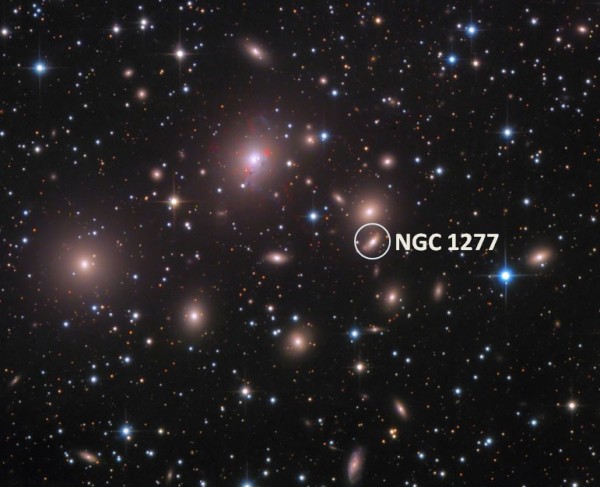 Image credit: NOAO / AOP, ©2005-2013 University of Texas McDonald Observatory, via http://blackholes.stardate.org/objects/image.php?id=82&img=225.
Image credit: NOAO / AOP, ©2005-2013 University of Texas McDonald Observatory, via http://blackholes.stardate.org/objects/image.php?id=82&img=225.
From Michael Kelsey on the Universe's largest black holes: "There seems to be a bit of controversy about NGC 1277; where do you stand on Eric Emsellem’s model estimate that the SMBH mass is only 2~5 GMsun? That puts it at just a few percent of the galaxy mass. The OJ-287 mass seems much more solid. Having a Keplerian system makes the problem more tractable, and less prone to model-dependent uncertainties."
There should be controversy about all the largest black holes. Which is to say, there are error bars and there are, as you eloquently put it, model-dependent uncertainties. Now, the question becomes how confident are we of these estimates?
For NGC 1277, we are looking at the kinematical behavior of gas. This is model-dependent, but it's a clear, direct measurement of a relatively nearby object that can be done directly with a space telescope. Emsellen's model seems a little pessimistic to me (I think it's unlikely), but it's not crazy and is definitely worth considering as an alternative. More data -- which means more measurements of objects like it -- will help us better understand what the masses of these objects are.
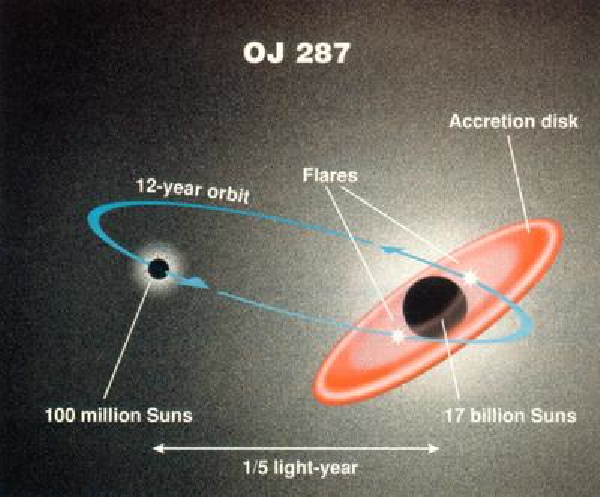 Image credit: Tuorla Observatory / University of Turku, via http://www.astro.utu.fi/news/080419.shtml.
Image credit: Tuorla Observatory / University of Turku, via http://www.astro.utu.fi/news/080419.shtml.
For OJ 287, there are uncertainties, too. Namely, uncertainties about the accretion disk and the interpretation of the data. If the system is as it's conjectured to be, it will be hard to wiggle too much, but if we wait for the next pass during the 11-12 year period and don't see the expected behavior, we will definitely have to re-evaluate.
That said, I think both systems -- NGC 1277 and OJ 287 -- or rather these classes of systems, should have more confidence placed in them than the class of supermassive black hole I didn't include in this discussion: the ones whose masses are extrapolated from Swift/X-ray data.
As Bryan Gaensler highlights in his book Extreme Cosmos, jetted AGNs emit characteristic X-rays due to the accretion disk around the supermassive black hole, and the X-ray spectrum is a function of the black hole mass. Using this method, SMBHs have been extrapolated to reach up to 40 billion solar masses. The problem (as I see it) is that none of the models fit well at all; the uncertainties are far too large (like, order-of-magnitude) to lay claim to a particular mass value with any real confidence. There are very likely more massive black holes out there, but the two I've referred you to -- NGC 1277's and OJ 287's -- are the two that I would confidently say we know are huge and there.
But there are uncertainties, and they are significant.
Image credit: ohmagif.com, original material from the Quantum Levitation video at ASTC 2011, via https://www.youtube.com/watch?v=Ws6AAhTw7RA.
And finally, an easy one from CB on quantum levitation: "Fun! Here’s another nice video from the Royal Institute where the track is a Mobius Strip so the superconductor “hangs” off the bottom on alternate trips around. It’s neat."
Let's take a look!
Thanks for a great week, some great comments and some great things to think about. I'm sure you have plenty to say about what I've said about history, ethics, and scientific confidence, but whether you agree or not I'm glad you're here and hope you enjoyed it!
- Log in to post comments

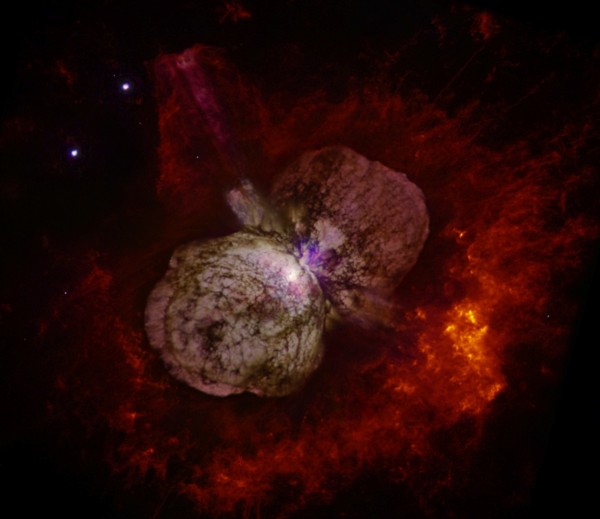
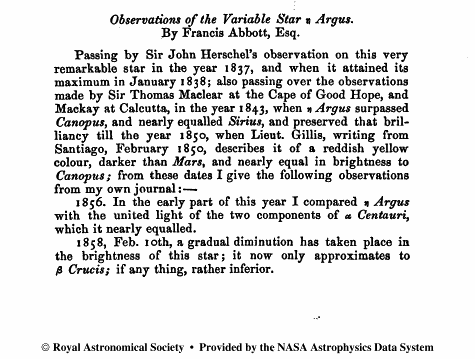

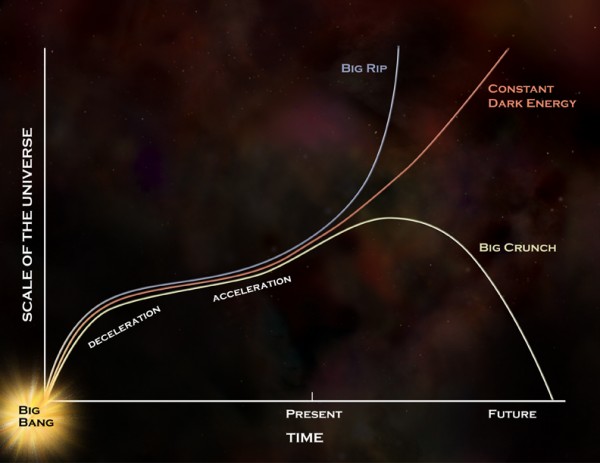

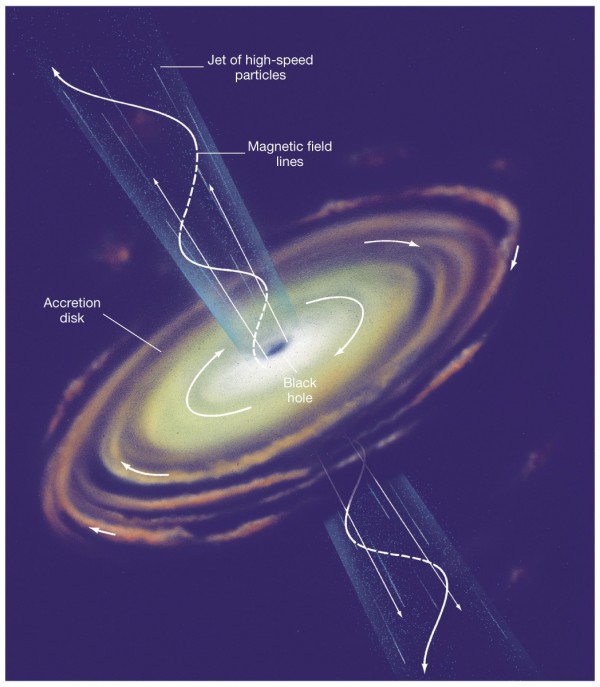
@Ethan: Thank you! My particle physics background keeps tripping me up: I'm not used to error bars that can span a factor of six or more, unless you're really setting an upper limit :-)
If both 3e+9 and 18e+9 are within a sensible range of models, then so be it. As you say, whatever the true number is, these things are huge, and hugely interesting!
Michael,
I haven't heard what van den Bosch has said about Emsellem's model; it would be interesting to learn what his thoughts are.
You've got to remember, in an environment like this, all we have is the kinematical gas measurements as far in as we can get them, which is going to confine us to a mass within a certain region. How much is bulge vs. how much is black hole? Unfortunately, it looks like the "wiggle room" here spans nearly an order of magnitude.
It's even worse for the X-ray extrapolated ones, and that's why I wasn't comfortable even including them in the discussion, although it seems that billion-solar-mass+ SMBH's are quite common. A better question may yet be why our galaxy's is so small!
@Ethan #2: Your comment about "why our galaxy's [SMBH] is so small" is right on. I looked at the Wikipedia list (http://en.wikipedia.org/wiki/List_of_most_massive_black_holes, which is trivially biased :-), and the only ones comparable to Sgr A* in the comparative list are from a couple of dwarfs.
It seems like many of these mass values aren't necessarily dynamical, but based on inferred correlations between SMBH mass and other observables. Even the dynamical estimator (velocity dispersion) seems to me to really be measuring the sum of SMBH and DM (or am I missing something?).
Is it possible that the low mass for Sg4 A* is a signal to us that those correlations are systematically over-estimated?
I'm not going to lie, having worked a little bit in observational astronomy: you always worry that the empirical correlation you're basing your work on has a cause that's different from the correlation you're seeing, and that ascribing a link between the variables you're working with is a red herring.
There is no substitute for a direct gravitational measurement like we can do with orbits, which is why I find OJ 287 so exciting. But only time -- and better data -- will tell us how much of what we think we know actually pans out. Before we had the direct gravitational data from stellar orbits, the consensus was our galaxy's SMBH was actually about 2.5 solar masses; the number rose dramatically with the new data. If someone claims a number with high precision for measurements like this, be very skeptical unless they've got a Keplerian orbit!